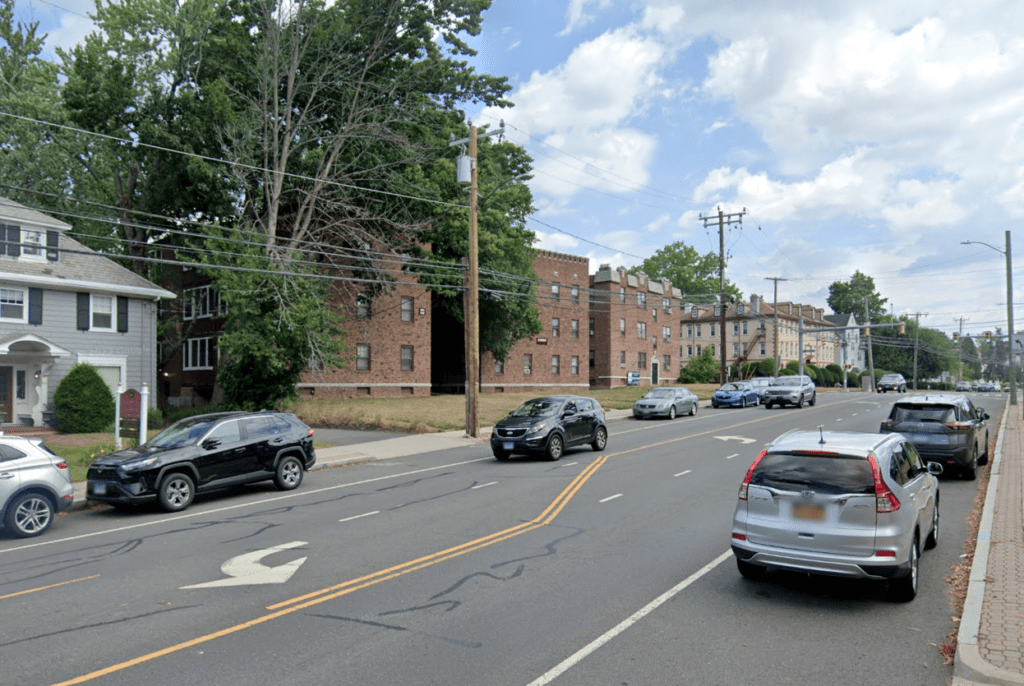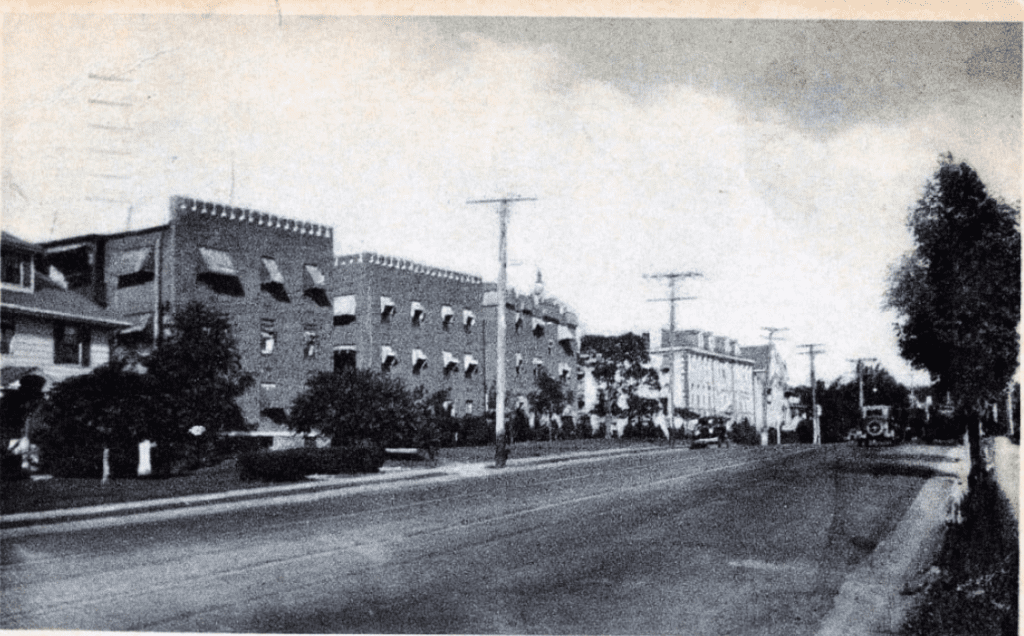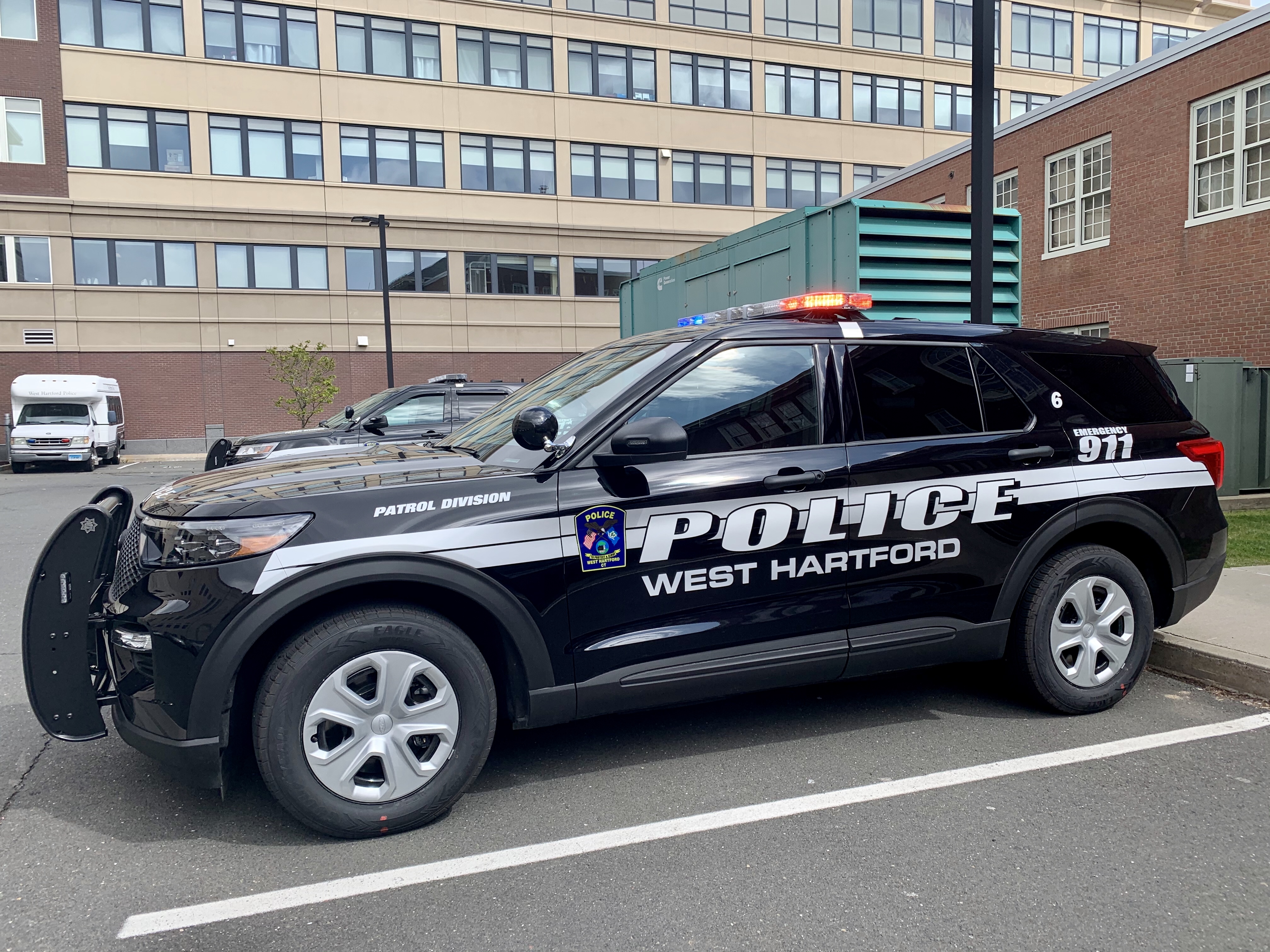From the West Hartford Archives: Farmington Avenue Near Quaker Lane

Audio By Carbonatix

Farmington Avenue looking east toward Quaker Lane. Courtesy of Noah Webster House & West Hartford Historical Society
Historian Jeff Murray takes a look into West Hartford’s past to uncover some surprising information, stir up some memories, or reflect on how much life has changed – or hasn’t changed at all. Enjoy this week’s ‘From West Hartford’s Archives’ …
By Jeff Murray
This is a view looking east on Farmington Avenue towards the intersection with Quaker Lane.
According to William Hall’s history of West Hartford (published in 1930), Quakers came to the town from New York state as early as 1780 to form a church and schoolhouse, purchasing an acre of land on the east side of Quaker Lane (of course named after their arrival!).
One of the more prominent Quaker families in the neighborhood were the Gilberts, as well as the Arnolds, Cadwells, and Sedgwicks. After growing up in the original homestead on North Quaker Lane, Benjamin Gilbert had a second house built at the northwest corner of North Quaker Lane and Farmington Avenue in the early 1800s (this was later moved north to a separate lot and is now the house at 15 North Quaker Lane). The Arnolds built along Farmington Avenue to the east of Quaker Lane.
The establishment of these families along this road at Farmington Avenue led to its Quaker name. Accordingly, since the families were concentrated around this center line of town, the section of Quaker Lane from Park Road south to New Britain Avenue was originally just called East Street and was only later rebranded to South Quaker Lane to align the whole road with the same name.
Benjamin Gilbert, born in the 1790s, owned all the land between West Hill Drive and Trout Brook, as well as the land north to a little past Fern Street and south to around where the Boulevard would be laid out. One of the more popular cider mills in the 1800s was located on the north side of Farmington Avenue near where Auburn Road is today, run by the Gilberts. Many people driving by on their way to and from Hartford would stop and drink “right from the press,” which apparently Gilbert made free according to Hall.
Gilbert married Rhoda Cadwell and they had eight children, although two did not survive beyond childhood which was normal for the time. Ironically, despite his influential place in the community, he actually petitioned against independence from Hartford in 1854. There were many reasons why prominent family members could have been against the independence of West Hartford, but after it was granted, almost all of these petitioners folded right back into the community effortlessly. Gilbert was no different.
After Gilbert died in 1868, the estate held property at every corner of Farmington Ave and North Quaker Lane except for the southeast corner. One of his sons, Erastus, a Hartford grocer, owned a few houses at the northeast corner, which were rented out.
Seth L. Gilbert, the last surviving child of Benjamin, died in 1912. He had been the proprietor of a carriage shop and gristmill further west at Trout Brook. During the Civil War, he made sashes and blinds. This property was later purchased by Edwin Arnold, founder of the Trout Brook Ice & Feed Company, in the 1870s, and Gilbert moved with his wife and children to Hartford in 1885.
A daughter, Cornelia, who had married John Carter, chief of the Hartford volunteer fire department, lived at the old Gilbert homestead until her death in 1894. Her husband became sick soon after her death and he passed just a year later. John D. Browne, an insurance man who had multiple large real estate holdings in town, bought the property at the corner before Carter died.
He was the first non-Gilbert owner in a hundred years and luckily bought it at the right time. The new trolley line had just been built along Farmington Avenue and telephone linemen were busy transferring wires to the new trolley poles. Unfortunately, the trolley switch that had been built at that corner led to some early problems – trolley cars would jump the track or crash into others often enough in the first few years.
The Quaker Lane stop became an easy spot for both residents living near the corner and for rowdy out-of-towners visiting here. Teenage boys from the Whiting Lane area and the Center district often stole signal lights and messed with the tracks. Some of the vacant land at the southeast corner had empty barns that were a prime spot for policemen hopping off the trolley to arrest any sleeping homeless people.
By 1909, Browne had sold the Gilbert homestead back to a very, very distant Gilbert relative and retained his holdings west of the corner around where Auburn Road is. This would later be sold off and subdivided during the World War I era.

A map of the area in 1909. Courtesy image
The property at the northeast corner consisted of a house owned by the Gilberts as well until eventually Edwin H. Arnold and his son Frederick, proprietors of the Trout Brook Ice & Feed Company, bought the land in 1900. One of the houses that they purchased was the Perkins house – Dr. Nathan Perkins, pastor of the Congregational Church during the American Revolution until his death in 1838, built it for his lawyer son.
It originally stood where West Hill Drive is, but was moved west by Erastus Gilbert and bought by Commodore Vanderbilt, the famous railroad tycoon, for his son. The family association with the property is the reason behind the Vanderbilt Hill name in this neighborhood.
After the Arnolds purchased the house, they removed it and moved it again, this time to face Farmington Avenue. It still stands after more than two centuries as a converted commercial space at 776 Farmington Avenue at the corner of Walkley Road.
In 1909, upon the improvement of the property, the Arnolds sold the land to a real estate syndicate, which subdivided it into lots and laid out Lilley Road, Walkley Road, Frederick Road, and Vanderbilt Road. The Arnolds retained the land fronting on Farmington Avenue for later use.
Within seven years, a significant block of houses were built in the Vanderbilt Hill subdivision for home owners, including a number of Jewish residents from Hartford. For example, Max Myers, an officer of the Congregation Beth Israel, was one of the first lot owners of this subdivision on Vanderbilt Road. Myers represented the congregation and bought the land for the new synagogue at 701 Farmington Ave in the mid-1920s before it was started in 1933 and was one of the initiators in its construction.

A map of the area in 1917. Courtesy image
The development of the northwest corner was worked in parallel with the Vanderbilt Hill neighborhood but much slower and by an individual developer. William S. Lines, who owned property all over town after his retirement in 1891 and who lived on Highland Street, bought a huge farm at the southwest corner of Fern Street and North Quaker Lane in 1904. The farmhouse on the property was originally that of Benjamin Gilbert’s brother Charles and possibly the original homestead. Over a century old, it tragically burned down in 1914.
After William’s death in 1911, his wife Carrie and son William Jr. managed the properties. Cottages were built up along the west side of North Quaker Lane starting in 1915. (They also bought an immense tract of land from Ardmore Road west to Trout Brook, but that will have to be the subject of another article!) They laid out Auburn Road from Fern Street to Farmington Avenue and the first houses went up there by the end of 1919. By the early 1920s, the only undeveloped land in the neighborhood was at the direct northeast and northwest corners, and that too was about to change.
The apartment building at the northeast corner was the first to go up. Edward Morris applied for the building permit in August 1922, at a time when the town saw a surge in building activity. Apartments were popping up all over town by this point, concentrated mostly on the east side and around Farmington Avenue. The northeast corner was just another victim of the hype of the apartment era.
The northwest corner still had a bit of time left though. Horatio H. Armstrong was an insurance man at Travelers Insurance for several years, born in St. Louis in 1880. After his wedding to Marjorie Edson in 1914 and a short stay at an apartment in Hartford, they bought the Gilbert homestead at the northwest corner in August 1916. They became very involved in the community through the 1920s. Horatio was president of the Quaker Lane Protective Association (essentially a neighborhood watch organization), and his wife ran events for St. John’s Church and Quaker Lane social clubs. Despite their community ties, they didn’t stay long though.
In 1924, the house was sold to Edward H. Molans and Fred Kenyon, who had developed many tracts in Hartford. They planned to build apartments, despite protests from neighbors. Accordingly, it was initially rejected by the zoning board, which was very new in town at this point and was able to flex its power a bit in determining the course of real estate development, even just by delaying construction. Only a few years later though, a second shot at construction and a change in mood allowed it to be approved by the board and 810/812 and 814/816 Farmington Avenue went up by 1927. The Gilbert home was preserved and moved one lot north to make way for the apartments.
The third apartment under construction had a little scandal when it was built at the immediate corner in 1928. Bowdoin F. Hazard, president of the real estate company that bought the property from Kenyon & Molans, skipped town and was sought by police for not paying wages to the construction workers.
Lastly, the house seen on the left side of the photo was older than the apartments. Despite the fact that public records say it was built in 1940, 818 Farmington Avenue was actually built in 1922 for Howard D. Graves, formerly sales manager of the Hartford branch of the Packard Motor Company. The fact that it was built 18 years earlier than publicly recognized may seem like a minor detail, but it also deprives the property of the historical recognition that it may receive if it continues to stand for another 50, 100, 150+ years.
At the point of this writing in 2023, all of the buildings seen in this photo still exist. The trolley tracks are no longer there, of course, but with our mood trending towards mass transit, perhaps one day they’ll be back.

Farmington Avenue looking east toward Quaker Lane. Google Street view

Farmington Avenue looking east toward Quaker Lane. Courtesy of Noah Webster House & West Hartford Historical Society
Jeff Murray was born and raised in West Hartford and has been involved with the Noah Webster House & West Hartford Historical Society since 2011 when he was a high school student and won the Meyer Prize for his essay on local history. Jeff routinely volunteers as local history researcher uncovering information for numerous museum programs such as the West Hartford House Tour and West Hartford Hauntings. Jeff works as a data analyst at Pratt & Whitney.
Like what you see here? Click here to subscribe to We-Ha’s newsletter so you’ll always be in the know about what’s happening in West Hartford! Click the blue button below to become a supporter of We-Ha.com and our efforts to continue producing quality journalism.




It’s interesting how the mature trees change the perspective. Thoughtful and well researched column. Thanks
Jeff, can you shed some light on the Childrens Museum on a corner of Farmington Ave. just past the Hartford line, moving East from prospect Ave. (on the right hand side) It was in a lovely old large home……..during atleast the 1940s. Students from East School walked to this museum periodically. I think the lady who ran it was Miss Chaney (sp) The reason I am asking is that a friend of mine, we both Hall High ;54 is working on her memoir and cannot find it at all on the internet. I am not sure if it was moved on to the Trout Brook Museum of later years. thanks…..